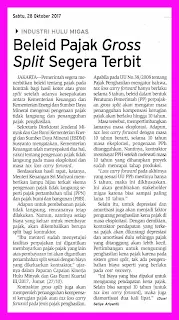Financial problems are the main obstacle in realizing the upstream oil and gas upstream target of 2017, which until the beginning of October was only US $ 6.74 billion from US $ 12.29 billion.
Head of Special Unit for Upstream Oil and Gas Business Activities (SKK Migas) Amien Sunaryadi said the problem not only affects small companies but also large companies, primarily for exploration activities.
"After the WP & B [work plan & budget] in September there are many that are not realized because there are many who are experiencing financial difficulties," he said after attending Exposure of Upstream Oil and Gas Performance Quarter III / 2017, Friday (27/10) .
As for activities in the production work area, capital expenditure targets are not achieved due to procurement factors. That is, as happened on the Madura MBH project.
Based on data from SKK Migas as of October 5, 2017, the realization of upstream oil and gas investment reached US $ 6.74 billion with US $ 6.18 billion of which came from the exploitation work area and US $ 560 million from the exploration work area. In fact, the target to be achieved for total upstream investment during the year is US $ 12.29 billion, referring to the 2017 revised work plan and budget (WP & B).
For investment from the production work area the target is US $ 11.42 billion and exploration of US $ 870 million. Throughout 2017, 2D seismic survey activities have been undertaken in 4 activities with an area of 3,929 square kilometers (km2) of 28 and an area of 10,338 km2. Meanwhile, for SD seismic survey activities, there are 6 activities with an area of 2199 km2 of 17 activities plan and an area of 6,151 km2.
It is estimated that by the end of the year, 11 out of 2D and 3D seismic survey activities will be realized. For the current exploration drilling has been realized 40 wells from the target of 44 wells. Meanwhile, it is projected that until the end of the year the drilling target will be achieved.
For development drilling, 128 wells of 215 wells were realized. On the other hand, the realization of work over 605 wells from 926 wells and until the end of 2017 will reach 925 wells.
LIFTING SAFE
Unlike capital expenditure, the projected achievement of ready-to-sell production or oil and gas lifting is even better. According to Amien, achievement of lifting will exceed the achievement of investment.
The lifting until September 30, 2017, amounted to 797,000 barrels per day (bpd) of oil from the target of 815,000 bpd and gas 6,367 mmsfd per day (MMscfd) and the target of 6,440 MMscfd refers to APBN 2017. For the achievement of oil lifting reaches 98% and gas 99%.
Amien said, if the realization of oil and gas lifting missed from the target, its achievement will be in the range of 99%. There are several projects expected to increase oil production by 2017 with a total of 705 bpd from West Madura Offshore Block of 105 bph and Rokan Block of 600 bph.
IN INDONESIA
Realisasi Masih Jauh dari Target
Permasalahan keuangan menjadi kendala utama dalam merealisasikan target investasi hulu minyak dan gas bumi 2017 yang hingga awal oktober hanya tercapai US$ 6,74 miliar dari yang ditetaplan sebesar US$ 12,29 miliar.
Kepala Satuan Kerja Khusus Pelaksana Kegiatan Usaha Hulu Minyak dan Gas Bumi (SKK Migas) Amien Sunaryadi mengatakan masalah ini tidak hanya berdampak pada perusahaan kecil tetapi juga perusahaan besar, utamanya untuk kegiatan eksplorasi.
“Setelah di WP&B [work plan & budget] bulan September ternyata ada banyak yang tidak terealisasi karena ternyata ada banyak yang mengalami kesulitan keuangan,” ujarnya usai menghadiri Paparan Capaian Kinerja Hulu Minyak dan Gas Bumi Kuartal III/2017, Jumat (27/ 10).
Adapun untuk kegiatan di wilayah kerja produksi, target belanja modal tidak tercapai karena faktor pengadaan. Hal itu, seperti yang terjadi pada proyek Madura MBH.
Dari data SKK Migas per 5 Oktober 2017, realisasi investasi hulu migas tercapai US$ 6,74 miliar dengan US$ 6,18 miliar di antaranya berasal dari wilayah kerja eksploitasi dan US$ 560 juta dari wilayah kerja eksplorasi. Padahal, target yang harus dicapai untuk total investasi hulu sepanjang tahun ini adalah sebesar US$ 12,29 miliar mengacu pada rencana kerja dan anggaran (WP&B) revisi 2017.
Untuk investasi dari wilayah kerja produksi targetnya sebesar US$ 11,42 miliar dan eksplorasi US$ 870 juta. Sepanjang 2017, telah tercapai kegiatan survei seismik 2D sebanyak 4 kegiatan dengan luas 3.929 kilometer persegi (km2) dari 28 dan luas 10.338 km2. Sementara itu, untuk kegiatan survey seismik SD, terdapat 6 kegiatan dengan luas 2.199 km2 dari rencana 17 kegiatan dan luasnya 6.151 km2.
Diperkirakan hingga akhir tahun akan terealisasi 11 kegiatan survey seismik 2D dan 3D. Untuk pengeboran eksplorasi saat ini sudah terealisasi 40 sumur dari target 44 sumur. Adapun, diproyeksikan hingga akhir tahun target pengeboran akan tercapai.
Untuk pengeboran pengembangan, terealisasi sebanyak 128 sumur dari 215 sumur. Di sisi lain, realisasi kerja ulang (work over) sebanyak 605 sumur dari 926 sumur dan hingga akhir 2017 akan tercapai 925 sumur.
LIFTING AMAN
Berbeda dengan belanja modal, proyeksi pencapaian produksi siap jual atau lifting minyak dan gas bumi justru lebih baik. Menurut Amien, pencapaian lifting akan melampaui pencapaian investasi.
Adapun, realisasi lifting hingga 30 September 2017, sebesar 797.000 barel per hari (bph) minyak dari target 815.000 bph dan gas 6.367 juta kaki kubik per hari (MMscfd) dan target 6.440 MMscfd mengacu pada APBN 2017. Untuk capaian lifting minyak mencapai 98% dan gas 99%.
Amien menyebut, apabila realisasi lifting migas meleset dari target, capaiannya akan berada di kisaran 99%. Terdapat beberapa proyek yang diperkirakan akan menambah produksi minyak di 2017 dengan total 705 bph dari Blok West Madura Offshore sebesar 105 bph dan Blok Rokan sebesar 600 bph.
Bisnis Indonesia, Page-9, Saturday, October 28, 2017







